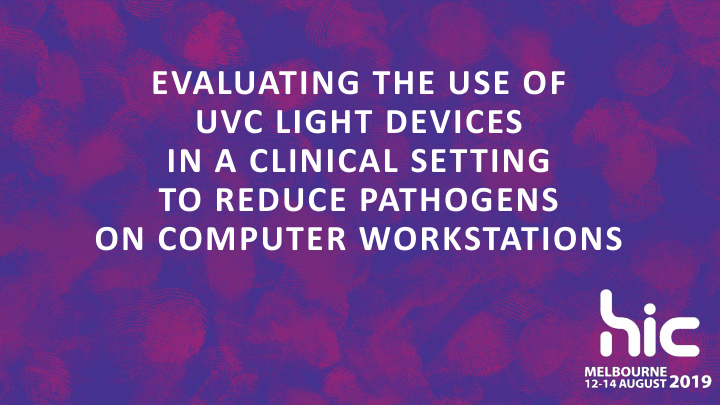



EVALUATING THE USE OF UVC LIGHT DEVICES IN A CLINICAL SETTING TO REDUCE PATHOGENS ON COMPUTER WORKSTATIONS
EVALUATING THE USE OF UVC LIGHT DEVICES IN A CLINICAL SETTING TO REDUCE PATHOGENS ON COMPUTER WORKSTATIONS WHO AM I? Steve Reinecke, MT(CLS), CPHIMS Clinical Scientist IT Manager – Cerner and Meditech Installs Ergotron AVP – Global Healthcare – 17 years VP of Business Development – Proximity Systems
Who is responsible for cleaning computers workstations in a Hospital?
A Potential Source of Pathogen Transmission Because many hospitals, clinics and care centers do not have routine cleaning of IT equipment, there is a high risk of contamination with pathogenic bacteria from the hands of healthcare workers (1). What is your hospitals protocol for IT equipment cleaning? 17 hospital touch screens cultured and identified pathogens (3). • C. diff. • VRE Study of 25 keyboards. All tested positive for growth of two or more microorganisms (2). • Klebsiella Sources: 1 Bures S, Fishbain JT, Uyehara, CFT, Parker JM, Berg BW. Computer keyboards and faucet handles as reservoirs of nosocomial pathogens in the intensive care unit. Am J Infect Control 2000; 28:465-70.; 2 Rutala, WA, White M, Gergen MF, Weber DJ. Bacterial Contamination of Keyboards: Efficacy and Functional Impact of Disinfectants. Infect Control Hosp Epidemiol 2006;27(4):372-377.; 3 Gerba CP, Wuollet AL, Raisanen P. Bacterial contamination of computer touch screens. Am J Infection Control. 2016;44:358-60.
HAI Facts: HAI s CAN I MPAC T ANYONE 8.6 % increase in of pathogens are transferred by additional hospital touch cost per HAI contracted patient Sources / Australian Guidelines for the Prevention and Control of Infection in Healthcare. Australian Government, National Health and Medical Research Council; 2019. / Mitchell BG, Shaban RZ, Macbeth D, Wood C-J, Russo PL. The burden of healthcare-associated infection in Australian hospitals: A systematic review of the literature. Infection, Disease & Health. 2017;22(3):117-128. / Russo PL, Stewardson AJ, Cheng AC, Bucknall T, Mitchell BG. The prevalence of healthcare associated infections among adult inpatients at nineteen large Australian acute-care public hospitals: a point prevalence survey. Antimicrobial Resistance & Infection Control. 2019;8(1). / The Secret Life of Germs. P Tierno, Atria Books. 2001.
Surface Sanitizing Today A disinfectant takes 3 to 4 minutes in a liquid state to completely eliminate pathogens and may take up to 10 minutes for more resistant pathogens. A quick wipe with a damp towel does not clean.
What is UVC?
UVC Technology Has Germicidal Effects “The incidence of target organisms among exposed patients was significantly lower after adding UV-C light to standard cleaning strategies. Ultraviolet disinfection is powerful and effective.” Source: BET-R study funded (in large part) by the Centers for Disease Control & Prevention (CDC)
Clinical Study Purpose: Demonstrate Efficacy of UVC Disinfection Device • Study located at HCA Houston Healthcare Southeast in the neurology unit and Intermediate Medical Care Unit (IMCU) • Study involved 52 computer workstations, that included 17 mobile computing carts and 35 in-room wall mounted workstations • Study aimed to prove automated UVC disinfection device is: • Effective at eliminating harmful pathogens • A complement to existing disinfection and hand hygiene protocols
Initial Swabbing During Clinical Study
Installing UVC Disinfection Device to Carts & Cabinets
Installing UVC Disinfection Device to Carts & Cabinets
Product Details • Motion activated for safe deployment of UV-C light • Automated cleaning cycle • Ran for 5 minutes every hour if no motion • If there was motion it waiting 1 minute for no motion and then ran for 5 minutes • 60 cm active cleaning area range • Internal memory and built-in audit trail • Different brackets for different applications • Flexible workspace configurations • Plugs into USB 3.0 port of power outlet • Over 3 year life on bulb based on normal hospital usage (2 year warranty).
How does it work? In independent testing by NSF International there was the following results: - 91.1% reduction in C. diff after 10 minutes of UVC exposure - 99.996% reduction in C. diff after 30 minutes of UVC exposure - 99.996% reduction in MRSA after 10 minutes of UVC exposure - 99.998% reduction in MRSA after 15 minutes of UVC exposure
Clinical Study Data Collection
Clinical Study Results
Safety • Automated ultraviolet disinfection cycles • Used a high speed camera to evaluate UVC Exposure Results exposure time and dosage 13.3 seconds of 30 uW/cm2, • Built-in motion sensor for safe operation resulting in just • After task is completed and if no motion is under 7% of the detected after a specified amount of time, maximum dosage a new additional cleaning cycle begins recommendation • After that cleaning cycle completes set by the NIOSH for an eight-hour shift. without interruption, UV-CLEAN reverts to operating under the scheduled cleaning cycles timeline
Further implementation of UV-Clean devices after the study.
Thank you! Steve Reinecke, MT(CLS), CPHIMS VP of Business Development sreinecke@proximitysystems.com +1 519.872.1490 PROX i M i TY PR TY 11301 Boudreaux Road, Tomball, Texas 77375, USA proximitysystems.com
Recommend
More recommend